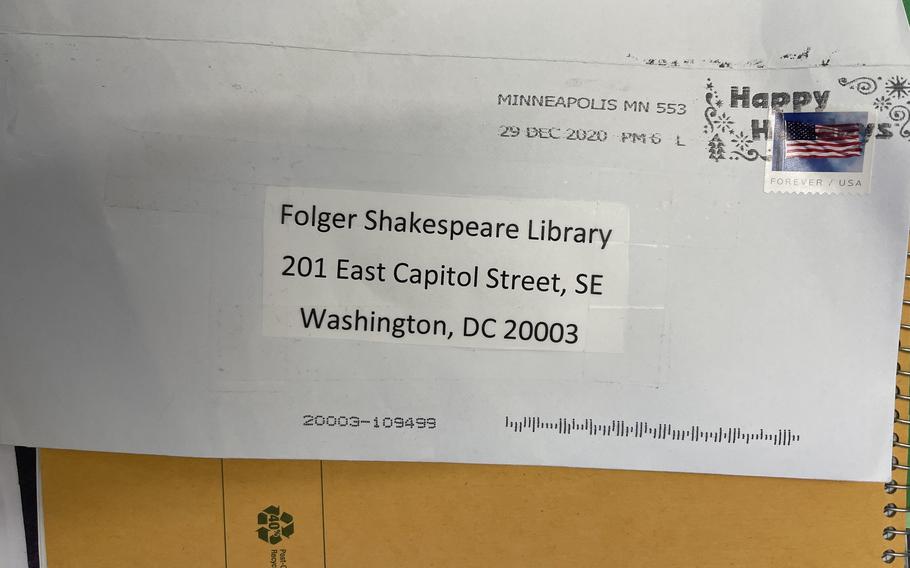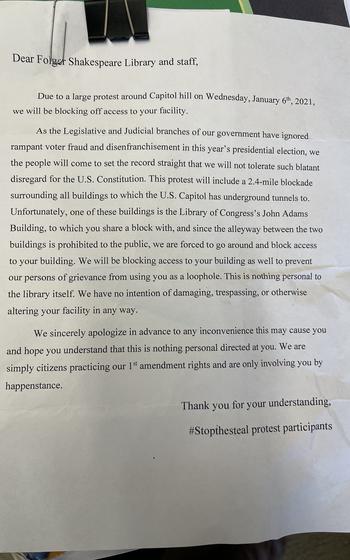
A week before storming the U.S. Capitol on Jan. 6, 2021, insurrectionists sent this letter to the Folger Shakespeare Library, warning of their upcoming action and pledging that the library would not be a target. (Folger Shakespeare Library)
While insurrectionists were plotting to storm the U.S. Capitol on Jan. 6, 2021, they took time to write and send a letter to an institution two blocks from their target: the Folger Shakespeare Library, the world’s largest collection of material related to the English playwright.
“We will be blocking access to your building … to prevent our persons of grievance from using you as a loophole,” read the insurrectionists’ letter, which circulated on a pro-Trump message board called TheDonald before the insurrection and was published this month in the Folger’s online archive.
The letter explained that the insurrectionists would create a 2.4-mile blockade “surrounding all buildings to which the U.S. Capitol has underground tunnels to” — including the John Adams Building of the Library of Congress, with which the Folger shares a block — presumably to prevent those inside the Capitol from escaping through the buildings.
“This is nothing personal to the library itself,” the letter continued. “We have no intention of damaging, trespassing, or otherwise altering your facility in any way. … We sincerely apologize in advance to any inconvenience this may cause you … we are simply citizens practicing our 1st amendment rights and are only involving you by happenstance.”
The letter was postmarked Dec. 29, 2020, and mailed from Minnesota. But the Folger didn’t receive it until almost two weeks after the insurrection, said Melanie Bender Martin, a spokesperson for the library. The letter is now in the library’s digital archive and will soon be made accessible to the public in the physical archive.
“As a library, we felt we had a duty to preserve the letter and make it available for future generations to reference,” Martin said. The Folger, with the exception of its theater, is currently closed for renovations, but when it reopens in June, Martin said, any member of the public will be able to make an appointment to view the letter in the building’s reading room.
It appears the Folger was singled out by the letter writers. Bill Ryan, communications director for the Library of Congress, told The Washington Post, “We have no record of having received a letter of this kind.”

The letter received by the Folger Shakespeare Library from people plotting the Jan. 6, 2021, insurrection. (Folger Shakespeare Library)
It might seem odd that the insurrectionists sent the letter to an institution that memorializes Shakespeare. But the Bard’s relationship to white nationalism — and specifically to a white American identity — has been long documented by scholars, including those who have drawn comparisons between the playwright’s works and the Jan. 6 insurrection.
In particular, white nationalists have invoked the play “Julius Caesar” to “emblematize America’s white Shakespearean-Roman inheritance,” Shakespeare scholar Arthur L. Little Jr., an associate professor at the University of California, Los Angeles, wrote in the introduction of a 2023 book he edited called “White People in Shakespeare.”
The Shakespearean tragedy follows the assassination of Julius Caesar, the ancient Roman dictator, by a group of conspirators who believed themselves to be guardians of democracy and feared Caesar was gaining too much power. The Jan. 6 insurrectionists — many of whom were neo-Nazis and white supremacists — claimed they were saving American democracy from election fraud by storming the Capitol.
“While it’s quite likely very few if any of those assembled at the Capitol on that day thought of Shakespeare or theatre … resonances of a white Shakespeare haunted the insurrection,” wrote Little. “Emulating Shakespeare’s ‘fierce fiery warriors’, the January-sixth insurrectionists, too, wanted to do more than imagine ‘drizzled blood upon the Capitol’: five people died and some one hundred and fifty were injured. It was white people’s Shakespearean theatre on a grand scale.”
The letter sent to the Folger suggests that some insurrectionists actually did think of Shakespeare leading up to the event. “I have drafted this short letter to the Folger Shakespeare Library as it will be within our perimeter and they have nothing to do with our protest or the theft of the election,” wrote a user named Minn2000 on TheDonald. The letter was signed anonymously by “#Stopthesteal protest participants.”
But Shakespeare’s relationship to white nationalism isn’t confined to the Jan. 6 insurrection; it has a long history that draws on Shakespeare’s role in constructing a white racial and cultural identity. Although Shakespeare was English, he has been invoked as a symbol of American linguistic and cultural heritage since before the revolutionary period. This heritage has often been tied to white supremacy.
The Folger Shakespeare Library’s first director, Joseph Quincy Adams (a relative of John Adams and John Quincy Adams), said in a speech at the library’s dedication that immigrants who were not from Northern or Western Europe “swarmed the land like the locust in Egypt,” and he saw Shakespeare as cementing America’s white, Anglo-Saxon heritage.
“The sentiments in that inaugural speech were an artifact at the time, but they’re also completely at odds with our sense that Shakespeare can be a vehicle for talking about what it means to live in a free and just society, one that is multiracial and democratic,” current Folger director Michael Witmore told The Post. A day after the Jan. 6 insurrection, the Folger published a statement denouncing the events.
While the Folger has distanced itself from its white nationalist origins and has made efforts to promote inclusivity, the relationship between Shakespeare and white nationalism has persisted into the present.
In June 2017, the summer after Trump’s election, two right-wing activists interrupted a New York Public Theater production of “Julius Caesar,” which depicted a controversial Trump-like Caesar in a production they believed represented “political violence against the right.”
Other American stagings of Shakespeare have also been embroiled in debates about white nationalism. In 1916, a New York production inspired by “The Tempest” represented an “Anglo-American claim to Shakespeare” by using Prospero’s authority to represent the dominance of Western thought and portraying Caliban, a dark-skinned man representing foreign-born populations, falling at his feet, Shakespeare scholar Elisabeth H. Kinsley noted in her 2019 book, “Here in This Island We Arrived: Shakespeare and Belonging in Immigrant New York.” This stood in contrast to the defiance of Shakespeare’s own Caliban against Prospero in the original play, Kinsley wrote.
Another famous invocation of Shakespeare in the service of white nationalism was directly rooted in violence. John Wilkes Booth, Abraham Lincoln’s assassin, came from a family of stage actors; his brother Edwin played some of Shakespeare’s most famous characters. Booth even starred in a production of “Julius Caesar” alongside his brother, playing Marc Antony, Caesar’s second-in-command, depicted by Shakespeare as loyal to the Roman dictator.
But Booth, a Confederate sympathizer and white supremacist, identified more with Shakespeare’s Brutus, who turned on Caesar; he invoked the character after shooting Lincoln, shouting, “sic semper tyrannis” (“thus always to tyrants”), a quote attributed to the real Brutus after he helped kill Caesar.
“After being hunted like a dog last night … I am here in despair,” Booth wrote in his diary after the assassination. “And why? For doing what Brutus was honored for.”